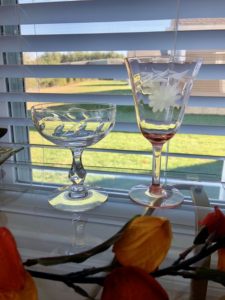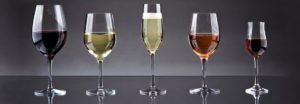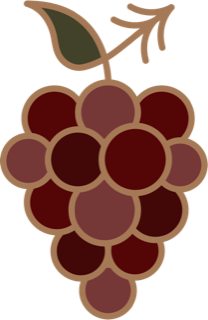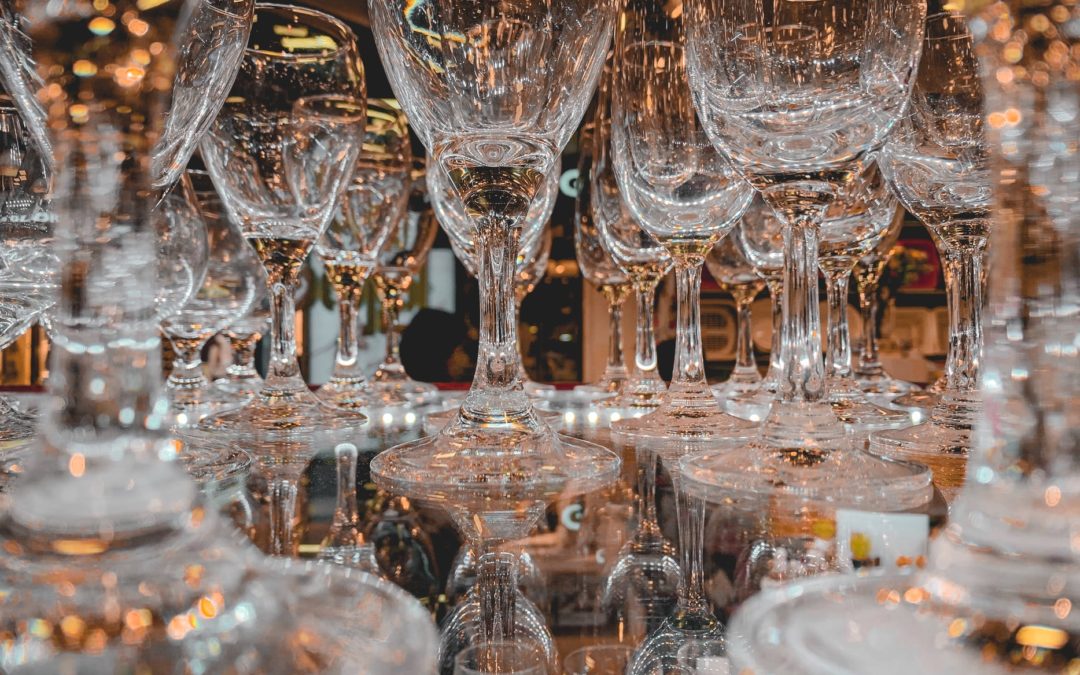A glass is a glass is a glass. That’s what I thought. Well, it turns out that there is actually some science behind which wine glass to choose for which wine. Although some glassware companies would lead you to think that you need a special glass for each varietal of wine grape, that’s not true…for the most part, that’s marketing.
I am fascinated by the different types of wine glasses, the colors, the etchings, the history. So, first of all, I’ll say that if you are doing a wine tasting to evaluate the wine in several glasses, you should use clear, stemmed wine glasses…period. These glasses allow you to evaluate true color, clarity, and density. They also allow for the swirl factor by having a stem to whirl around. Most wine experts agree that a clear glass with a medium-sized bowl and a stem is best.
For those interested in vintage glassware, I personally am partial to pink etched glass wine glasses. I also like clear etched wine glasses. I will only use a colored wine glass for a holiday toast. Most specifically Christmas and my red Lenox Champagne flutes. Yes, they are red, but the holiday season just begs for the color red. If you are in search of vintage wine glasses, visit some of your local antique shops and focus on glassware. I have so much fun hunting for interesting patterns and shapes. Recently, a friend of mine found 5 pink etched small wine glasses at a vintage shop. Knowing that I was searching for them, she bought them, and now they are proudly displayed in my hutch (or wine glass cabinet…since that’s all I have in there). Another one of my favorites is the vintage Champagne coup. They are usually clear, etched, and give off a really cool 1920’s feel to a gathering or a dinner party. Plus, the rumor is that it was fashioned after Marie Antoinette’s bosom. See if you can find some, give them a try. Champagne, cocktails, whatever…you’ll be the bee’s knees!

So, let’s get down to it. Generally speaking, for white and red wine, there are 2 standard glasses. They are both clear with a stem. The standard white wine glass has a narrower rim to keep the aroma of the wine concentrated in the glass longer. The smaller bowl size helps to keep the wine cool. You should hold a glass of white wine by the stem so as not to heat the wine inside the glass with your hand. (Chardonnay, Sauvignon Blanc, Viognier, Chenin Blanc, Chablis, etc.)
The standard red wine glass has a large bowl and a slightly tapered rim. Typically, red wine has more alcohol than its white counterpart. It also has tannins (mouthfeel, bitterness). The larger bowl provides more surface area to allow the wine to aerate and soften the tannins. The stem is usually taller with a red wine glass to allow for more distance between the wine and the nose. (Cabernet Sauvignon, Cabernet Franc, Grenache, Zinfandel, Syrah, Malbec, etc.)
There are a few “standard” glasses for sparkling wines. There are the flute and the tulip. Both allow for the bubbles to stay fresh and bubbly in the glass and the aroma to stay concentrated. Like white wine, you should hold a flute/tulip glass on the stem so as not to heat the wine. (Champagne, Prosecco, Cava, Sparkling wine, etc.)

If you want to buy into the marketing, (I’m guilty of this) you can try the different other types of glasses made specifically for a varietal of wine. Here are a few of the more common ones.
Pinot Noir: This is a broader bowl than the standard red wine bowl and the rim curves in and out to allow for the aromas to stay in the glass longer. The aromas in a Pinot Noir are everything, as far as I’m concerned. The Oregon Pinots are something special. They even have their own “Oregon Pinot Noir glass”. It’s lovely and most will hold an entire bottle of wine! I didn’t believe it either, but I tried it and it does! Amazing!
Riesling: This white wine can be dry or sweet, but the glass is smaller than the standard white wine glass. Riesling is known for its delicate aromas and so a narrower glass with a tapered rim is in order. It helps to keep the scent inside the glass longer. This type of glass can also be used with Sauvignon Blanc.
Rosé: For a young Rosé, go for a flared rim glass with a smaller bowl. This will enhance the flavor and crispness as it hits the tip of your tongue. For a more mature Rosé, use a glass with a tapered rim and a rounded bowl. This will help the aromas to open up.
Port and other Fortified wines: The best glass for this type of wine is a glass with a small bowl. These types of wine are generally higher in alcohol and a small glass reduces alcohol evaporation and helps to keep the aroma in the glass. It can be enjoyed one sip at a time.
A word about stemless wine glasses. I’m really not a fan because I find them difficult to hold on to. If you want to give them a try, use them with red wine. White wine in a stemless glass will lose its cool temperature quickly. Plus, with stemless wine glasses, there’s the fingerprint and handprint issue…I don’t know, maybe that’s just me.
But whichever glassware you choose, whether it’s specific to the varietal or a standard white and red wine glass, buy several of them. Trust me, they will break along the way and you’ll definitely need more than you think.
If you want more info and are into the collection of wine glasses for all varietals, check out the Riedel website. They are the professionals in all things glassware for wine.
www.riedel.com/en-us/riedel/why-shape-matters
Cheers!


I loathe stemless glasses! Why?! They are not good for wine.
Coups are fun! Especially because of the Marie Antoinette history behind it. Although, they spill easily. 😉
I have some aperitif glasses you need to try.